In the opening round of the Bundesliga 2020/21 season, Werder Bremen hosted Hertha Berlin at the Weserstadion. The game ended in a disappointment for the home fans with a 1-4 defeat giving a poor impression to start the season after a relegation scare last season. Hertha Berlin, on the other hand, looked sharp with their tactics and started their season with a lot of promise.
In this tactical analysis, I shall assess the strengths of Hertha Berlin in controlling different phases of the game. I shall also explore the weaknesses of Werder Bremen with an analysis of their system involving the new transfer, Tahith Chong, and propose how they could have approached the game differently.
Lineups
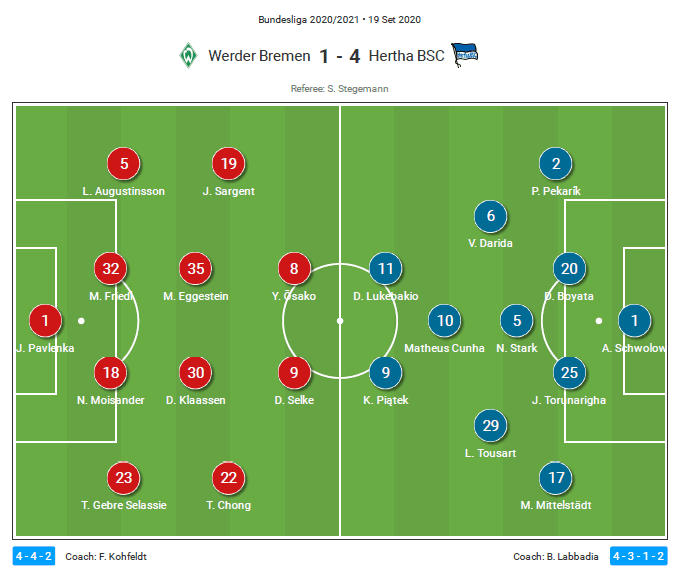
Werder Bremen
Jirí Pavlenka, Marco Friedl, Niklas Moisander, Ludwig Augustinsson, Theodor Gebre Selassie, Maximilian Eggestein, Davy Klaassen (63′ Niclas Füllkrug), Yuya Osako, (45′ Leonardo Bittencourt), Davie Selke, Joshua Sargent, Tahith Chong (63′ Nick Woltemade)
Head coach: Florian Kohfeldt
Hertha Berlin
Alexander Schwolow, Jordan Torunarigha, Dedryck Boyata, Niklas Stark (81′ Arne Maier), Maximilian Mittelstädt, Peter Pekarik ( 81′ Deyovaiso Zeefuik), Matheus Cunha, Lucas Tousart, Vladimir Darida, Krzysztof Piatek (61′ Jhon Córdoba), Dodi Lukebakio (81′ Mathew Leckie)
Head coach: Bruno Labbadia
Kohfeldt played a 4-2-2-2 system which was unusual to the attacking 4-3-1-2 system that he usually plays. In front of a central midfield of Eggestein and Klaassen, Sargent and Chong sat in the half-spaces and Selke and Osako played up top with Selke tasked at pressing the backline and Osako slightly deeper. This system had lot of issues to Bremen’s style of play as I shall elaborate further on.
Labbadia shaped his Hertha side in a 4-3-1-2 with a very fluid system that allowed forwards to drop deep and receive the ball and the midfielders to rotate with the fullbacks. The forwards would also play an active role in pressing from the top closing the space in the midfield. This system provided supported the creativity of Cunha and Tousart while exploiting the pace of Mittelstädt and Darida.
Problems with Werder’s structure
Out of possession, Werder sat passively in their 4-2-2-2. They held a zonal block with a moderately high line and did not close down players who dropped deep to receive the ball. Here below, we see how they held their shape allowing Hertha to have possession from the back.
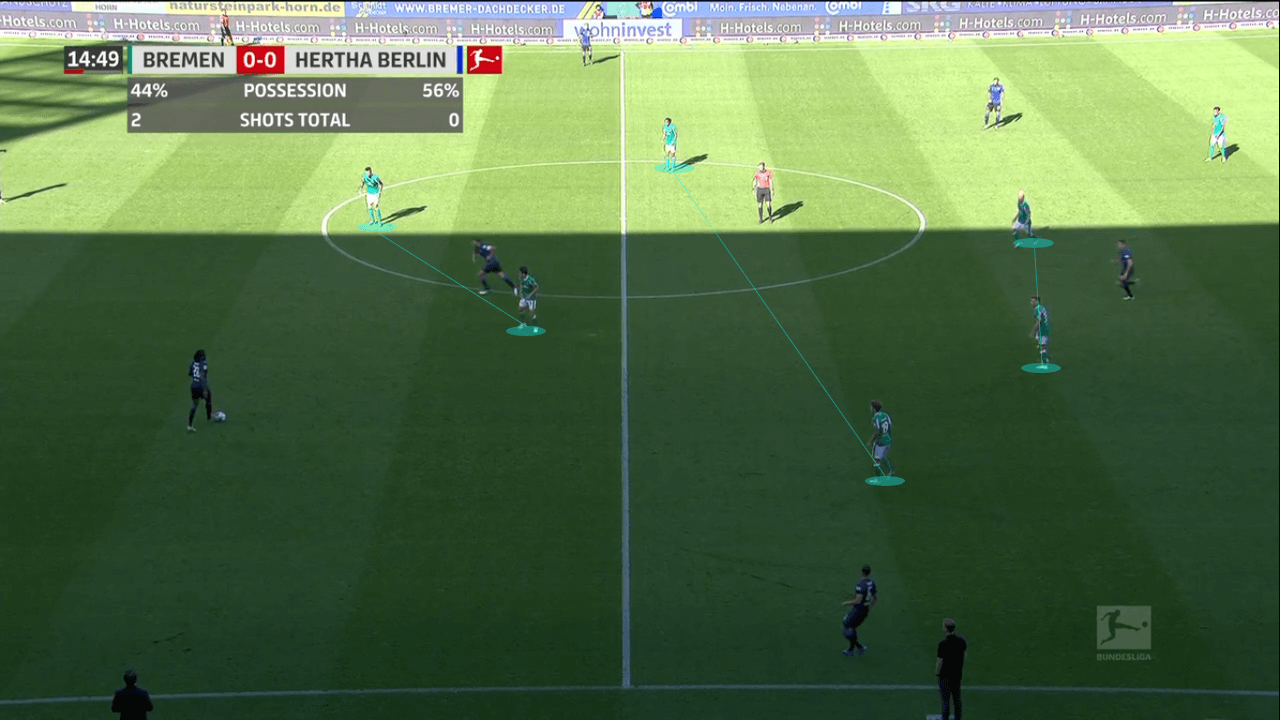
Osako was tasked at staying close to the Hertha captain, Stark who was the first line of pass out of the defence. Here we see him keeping the holding midfielder in his cover shadow to cut the passing lane from the defence. Chong and Sargent would not be dragged too high and wide in closing down the fullbacks but their job was to control the spaces in the inside when possession was won and attack between the centreback and the fullback.
The 4-2-2-2 system with two attacking wide midfielders and two central midfielders behind two strikers left a big hole in the centre of the structure. Essentially there was nobody to control the play creatively in the middle when Werder was in possession. Chong would have liked to cut inside and control the space in the inside corridor but that meant there was nobody attacking the right flank, so he had to attack that space himself instead.
I shall elaborate more about Hertha’s pressing system in the following sections but let me give an example of how Werder were closed down while trying to play in the pockets. Below we see a situation with Werder in possession and Osako is positioned between the lines in the half-space to receive a pass from Friedl. Augustinsson is making a run on the outside flank. An ideal link would be a pass to Osako that is laid off to the fullback wide and then move forward.
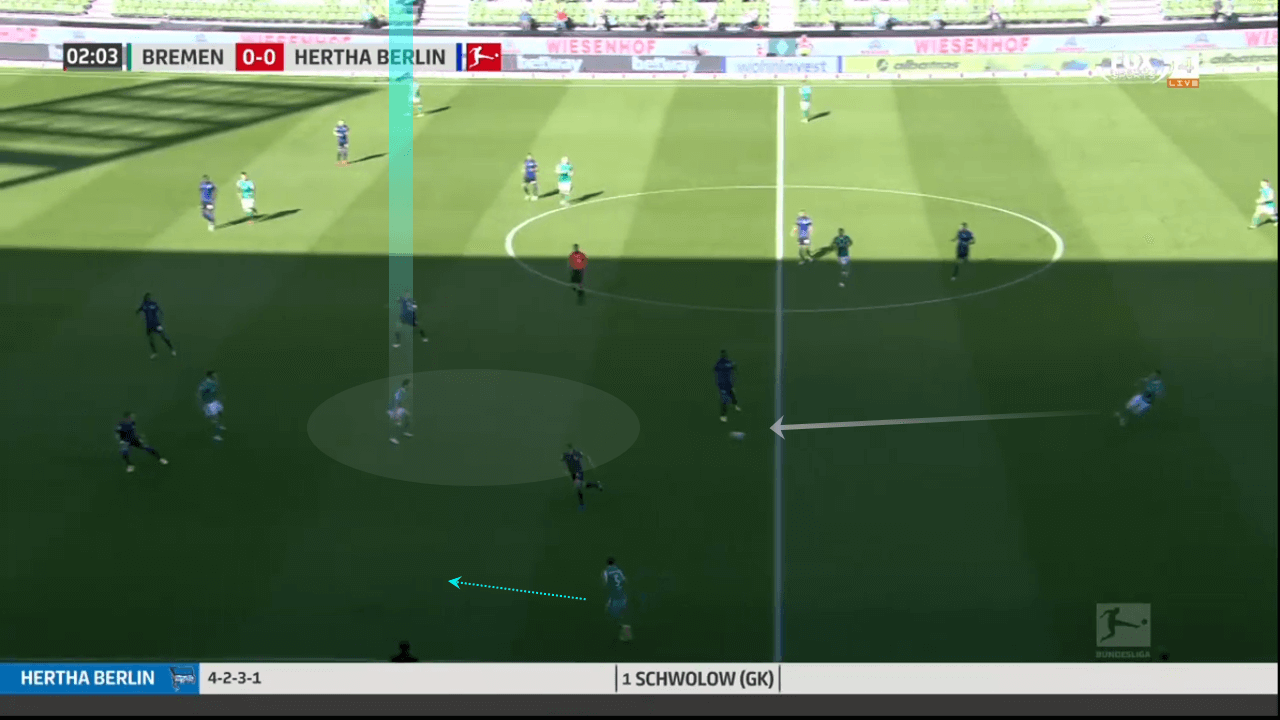
But we see Osako pass cut out by Darida who transitions back in time. We also see how Osako is closed down giving him no time to take another touch and look for other options. Stark closes him from behind and the forward, Lukebakio is also tracking back defensively to prevent the pass back to Friedl. This is how Hertha managed to close down Werder from playing through the middle quite effectively.
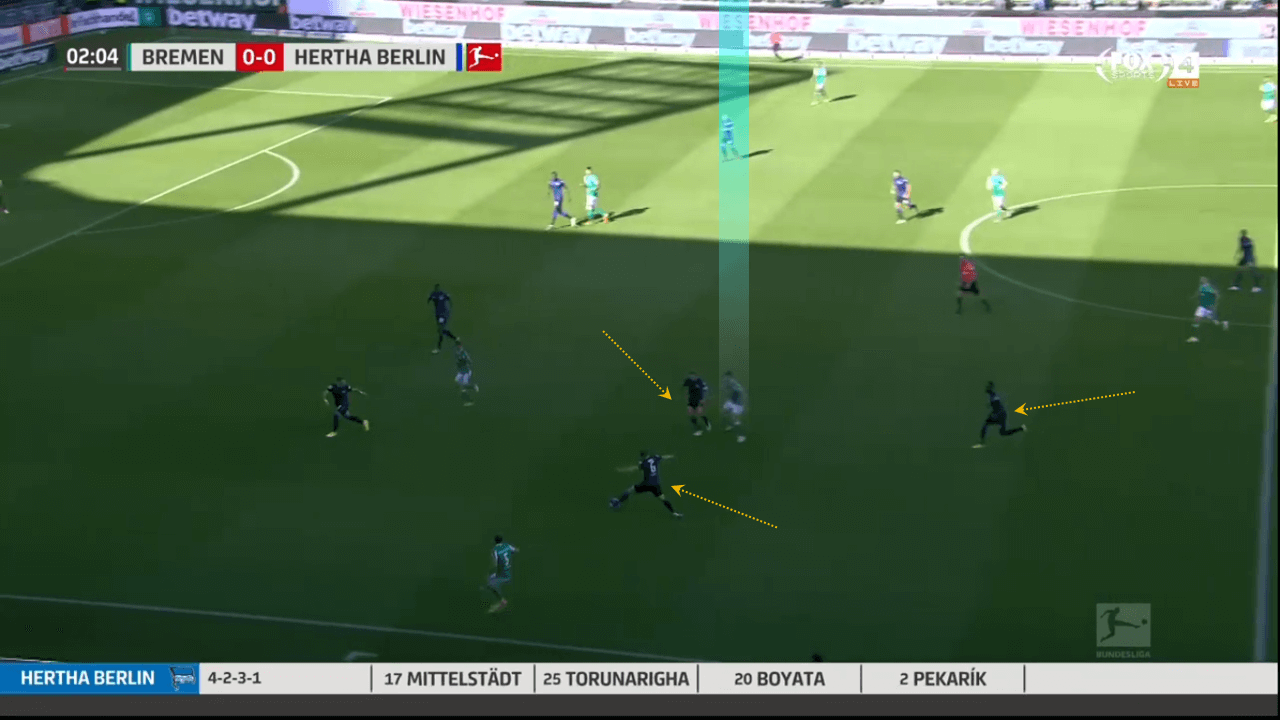
Kofeldt was forced to take off Osako at half time to bring on Bittencourt who provided more attacking creativity in the middle sitting behind Selke, but the lack of width in attack started to become evident.
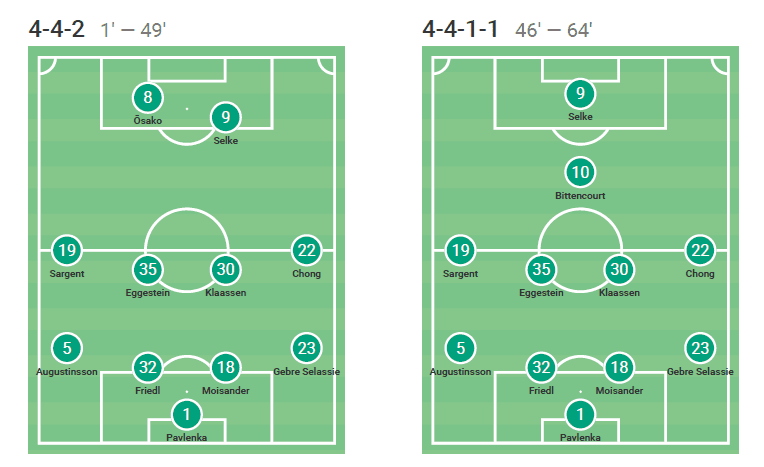
Werder’s lack of width in attack
The other major issue with this structure was that the Werder forwards were positioned too centrally in attacking transitions. Chong was instinctively drawn centrally and Sargent is used to playing as a forward so they pushed along the half-spaces in attack. Usually, this would require the fullbacks to overlap and offer the width for a diagonal ball to switch play if needed. But Gebre Selassie was occupied defensively in this game so Werder heavily missed an attacking option on the far right.
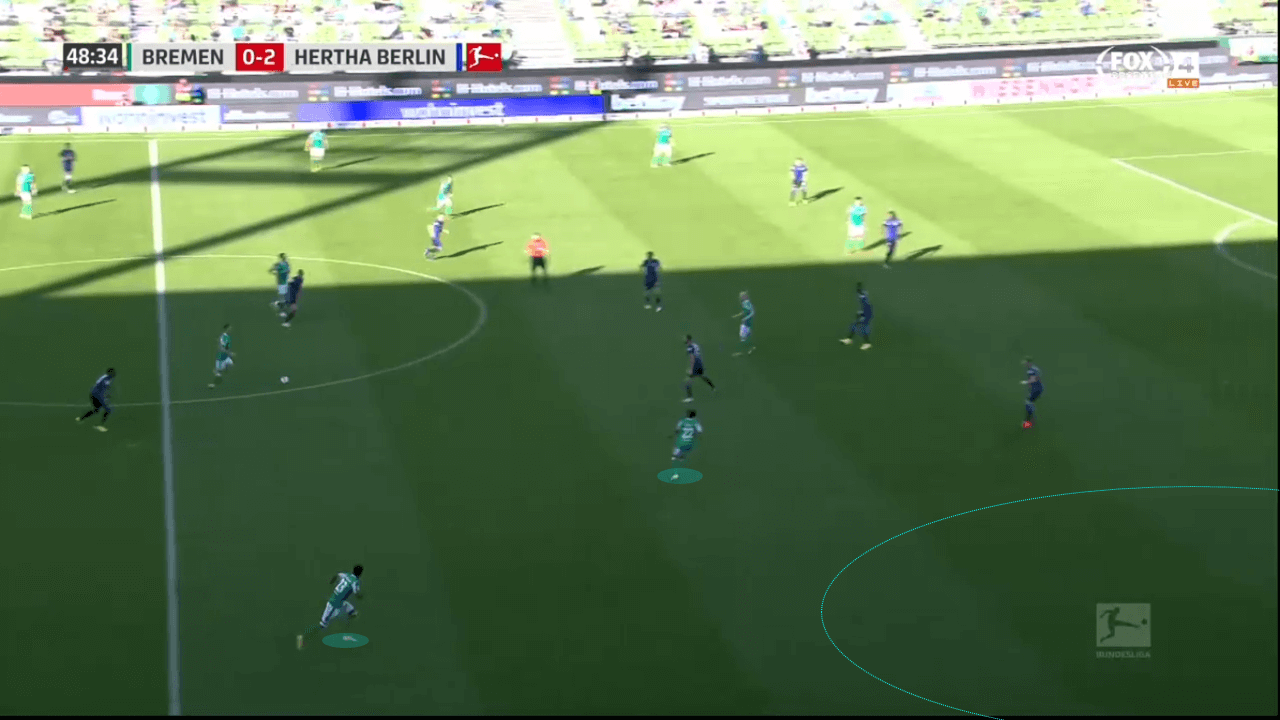
Above we see Eggestein in possession of the ball, but Chong has pushed inside into the half-space and thereby there is nobody on the wide right as an attacking option for Eggestein. Gebre Selassie, the right-back, is making a sprint, but he is late as he was tasked at defending in the previous action. Thus Werder has a big hole in their attacking shape on the right side.
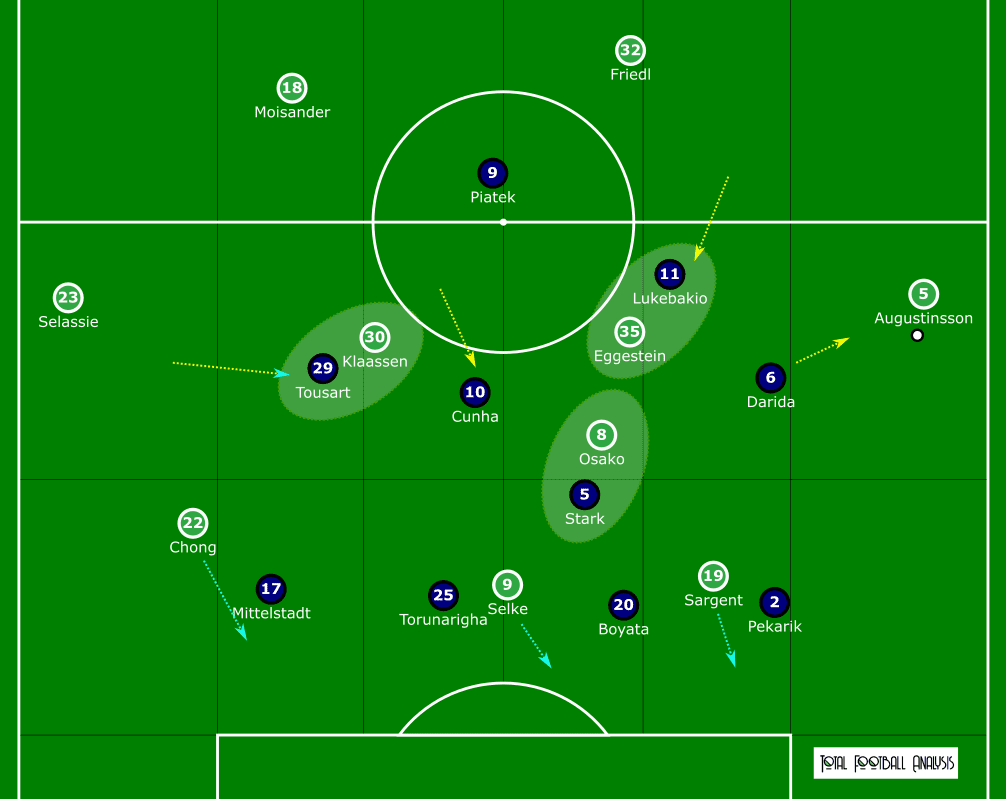
In this scheme above, we see Augustinsson in possession on the left. There is no option to play through Hertha’s structure because of their effectiveness in closing down the midfielders. At the same time, there is no wide option for Augustinsson as Sargent is positioned between Pekarik and Boyeta attacking the space behind. Hence the only option is to play the long ball behind the defence.
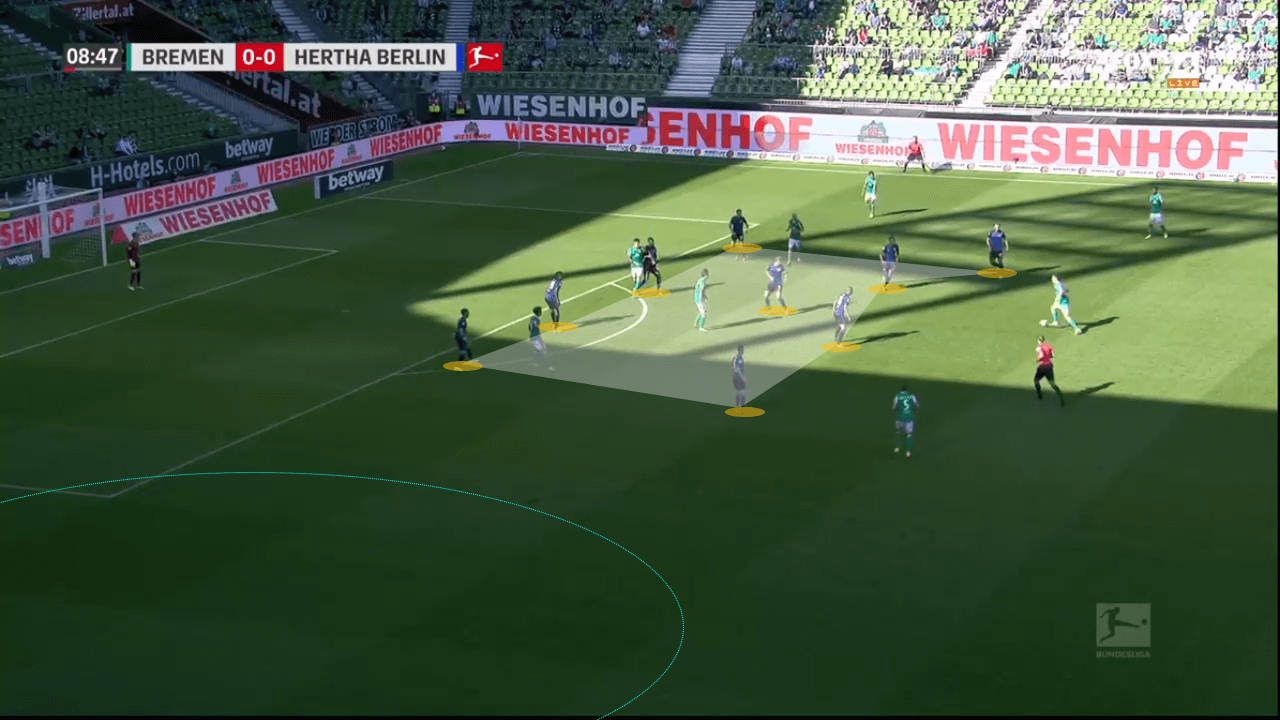
Let us take this instance when Hertha were pushed to defend a very compact block in front of their box and Werder is in possession. The midfielder Eggestein is looking to play through the structure while nobody is positioned in the vast amount of space on the left side as an option to play around it. We see that Augustinsson is positioned quite centrally to Eggestein’s left. Augustinsson did manage to make a few strong runs along the left flank, and one of them actually managed to provide the cross and assist for Selke’s header and Werder’s only goal in the game.
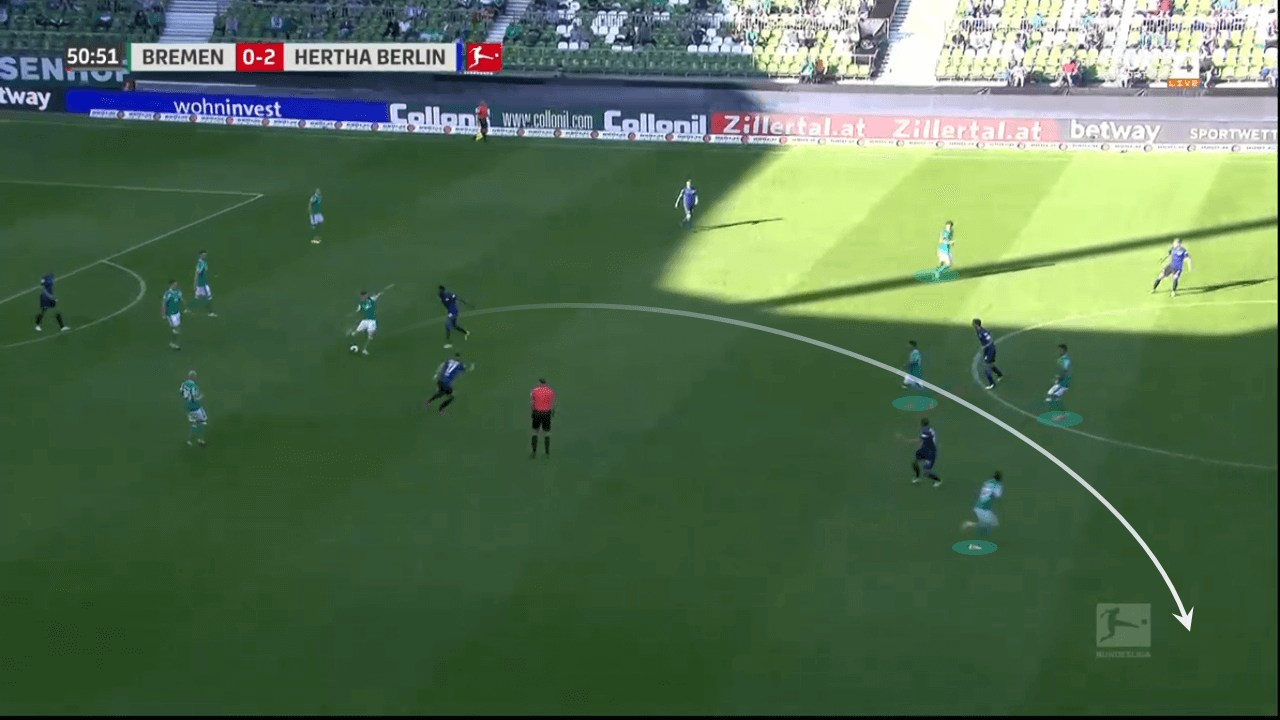
Above we see another instance when Eggestein has won the ball in front of his defence, He is looking to play the diagonal ball to the right but all four Werder forwards are positioned centrally and there is no option on the wide side to receive the long ball. The right-back Gebre Selassie would be the usual runner to attack the right side, but in this game, he was too held back defensively.
Hertha’s pressing system
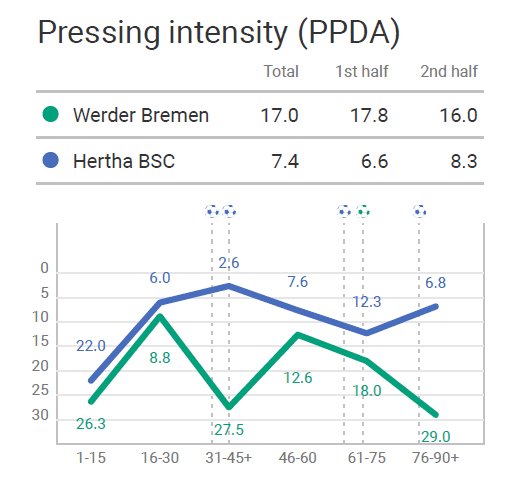
Hertha’s 4-3-1-2 allowed the forwards and the midfielders to press as a unit and cover for each other when one player was drawn out of position because of moving out to press. They maintained a consistent pressure with an average PPDA of 7.4 which was much better in comparison to Bremen who had a PPDA of 17.0. They did not need to press very high but in the right moments, their pressing scheme allowed them to maintain structural balance very well. Let us look at how their pressing structure worked in the defensive phase.
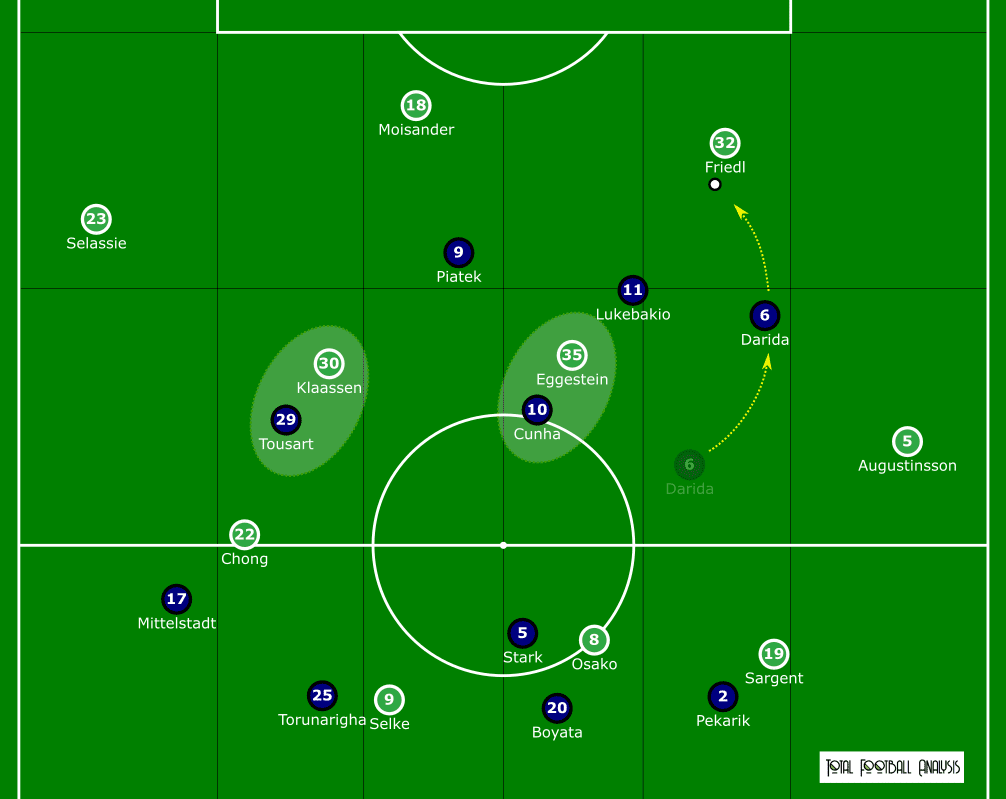
Above we see this graphical scheme where Augustinsson passes the ball back to Friedl. This is the trigger for the right midfielder Darida to leave his position and press forward while Cunha marks Eggestein and Tousart marks Klaassen closing down the two central midfield options. The forwards are positioned well to press the only option which is the pass to Moisander.
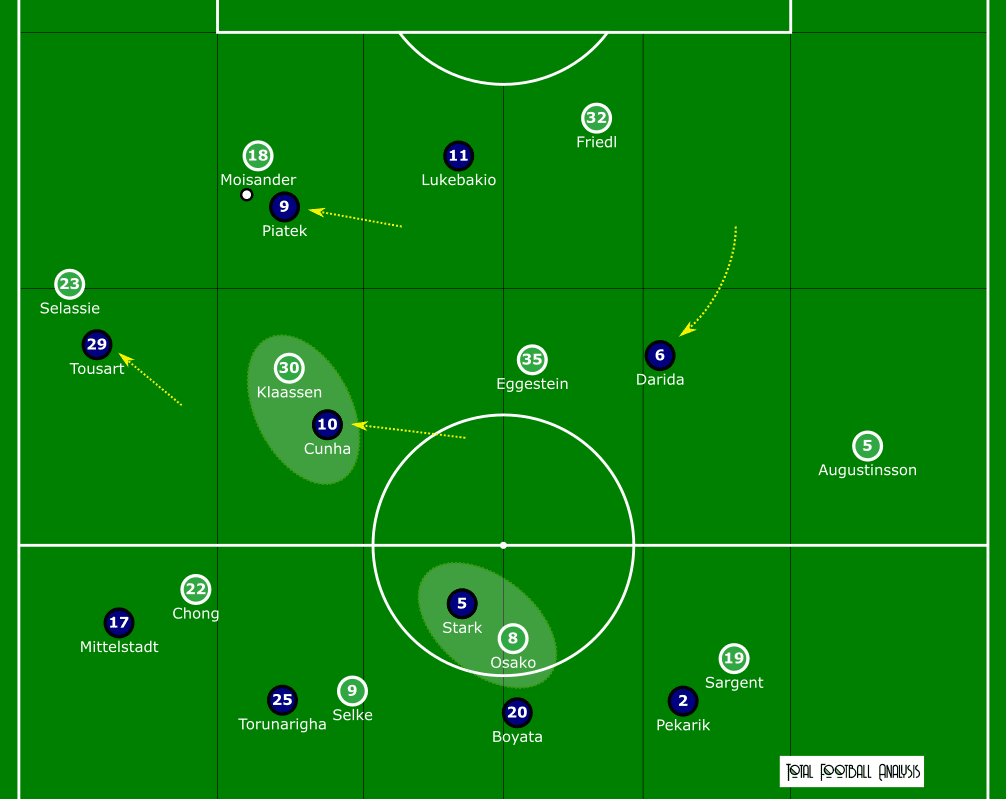
As the pass is played to Moisander, the whole structure shifts to the left with the centre forward, Piatek pressing the ball carrier, Tousart leaving Klaassen to press Gebre Selassie and Cunha leaving his original mark, Eggestein and transferring to Klaassen. Darida now falls back to stay close to Klaassen. Notice that during this entire movement, the back four is able to maintain their line and Stark is able to close down Osako securing his defensive line from the front.
We have seen how Hertha organised themselves in complete defensive phases, so let’s see how they pressed in defensive transitions as well. In this instance below, Woltemade has won possession of the ball and is looking for an option on the right.
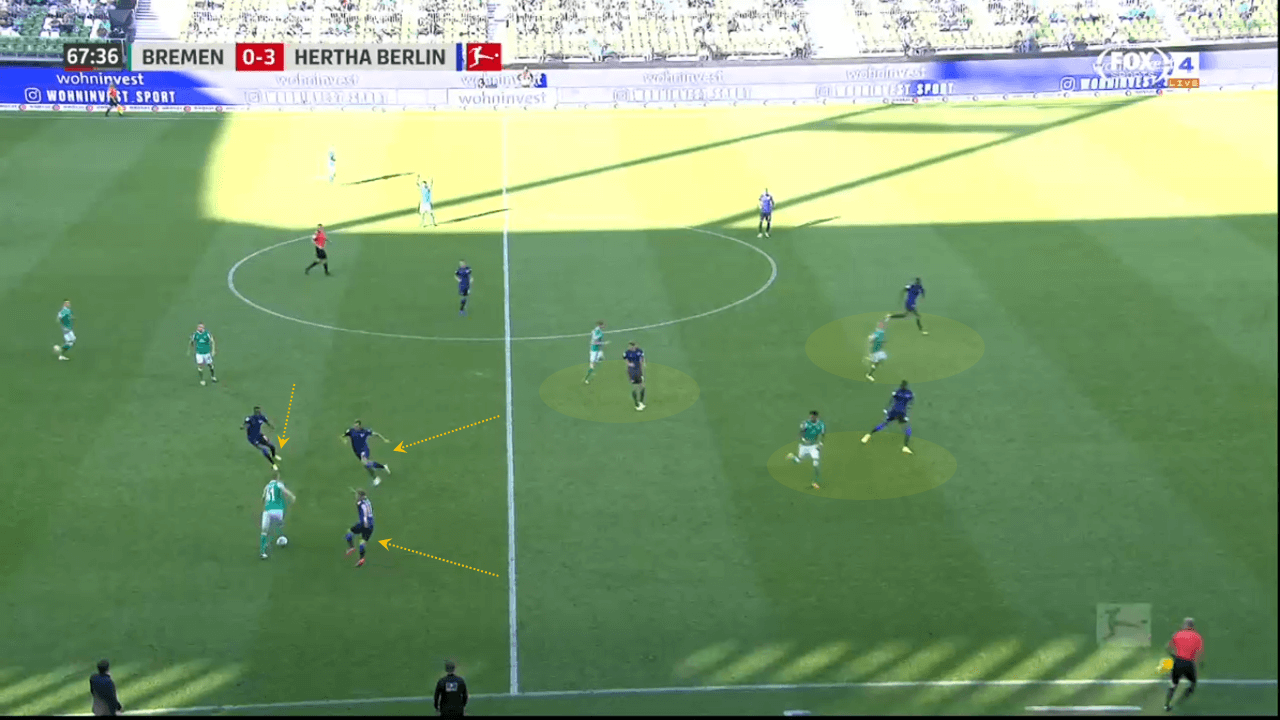
Cunha, Tousart and Cordoba immediately counter-press him to close the space for him to take another touch. Behind them, Stark is marking Sargent and the defenders are ready to track a through pass to the forwards. Thus Hertha have successfully closed down all options for Woltemade. On the far left, we see Bittencourt throwing his hands up trying to catch Woltemade’s attention, but with such aggressive counter-pressing it is impossible to pick your teammate out to find a pass.
Hertha’s man-to-man press when Bremen played out from the back
Hertha’s man-oriented pressing worked well especially when Werder tried to play out from the back. I picked out two instances that demonstrated how they managed to close down Werder playing out from the back.
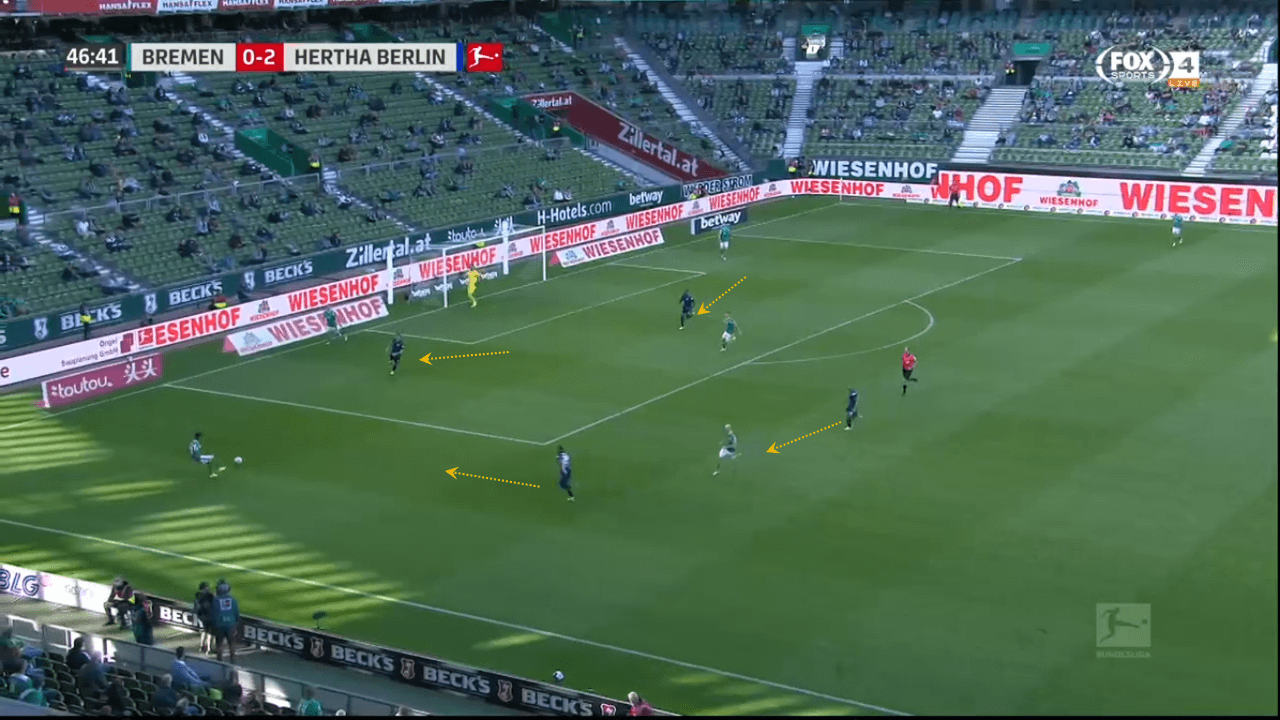
In the first instance above, the ball is played from the keeper, Pavlenka to Moisander, who plays it to the right-back Gebre Selassie. There are four players on the right including Eggestein and Klaassen who were options for the short pass. All four options are closed down because of four Hertha players pressing high making it 4v4. This forces Gebre Selassie to play the long ball to go around Hertha’s structure.
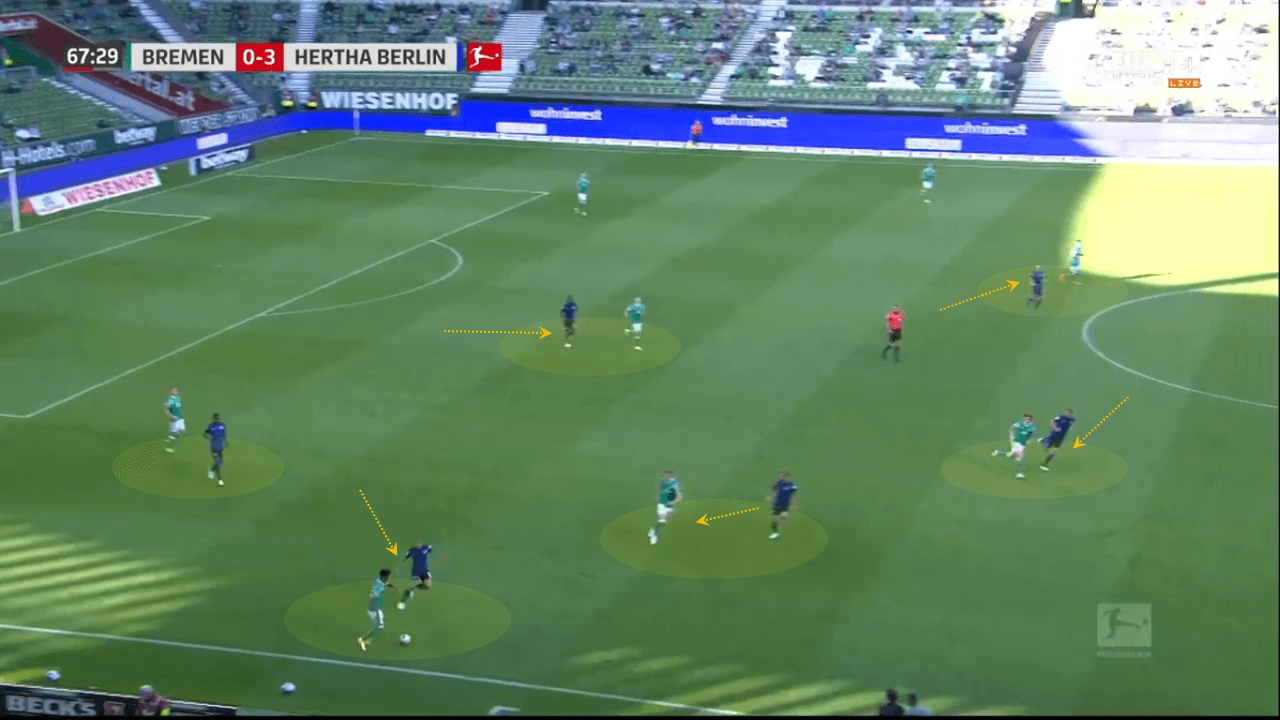
In the next instance we see again Gebre Selassie, but a little more advanced along the pitch. We see how Hertha has closed down all the options in an intensive man-oriented press leaving the free players on the other side of the pitch who cannot be easily accessed by the player in possession of the ball in this situation.
This ensured that the fullbacks of Bremen were trapped and forced to play the ball long where the defenders and midfielders could contest and win the aerial duels and the second balls.
Rotations from the forwards
Hertha’s influential aspect during their game was their rotations to make options while playing out of the back. Bremen’s zonal 4-2-2-2 block enabled the rotations to be performed with greater success. The rotations also managed to create overloads in central and wide areas.
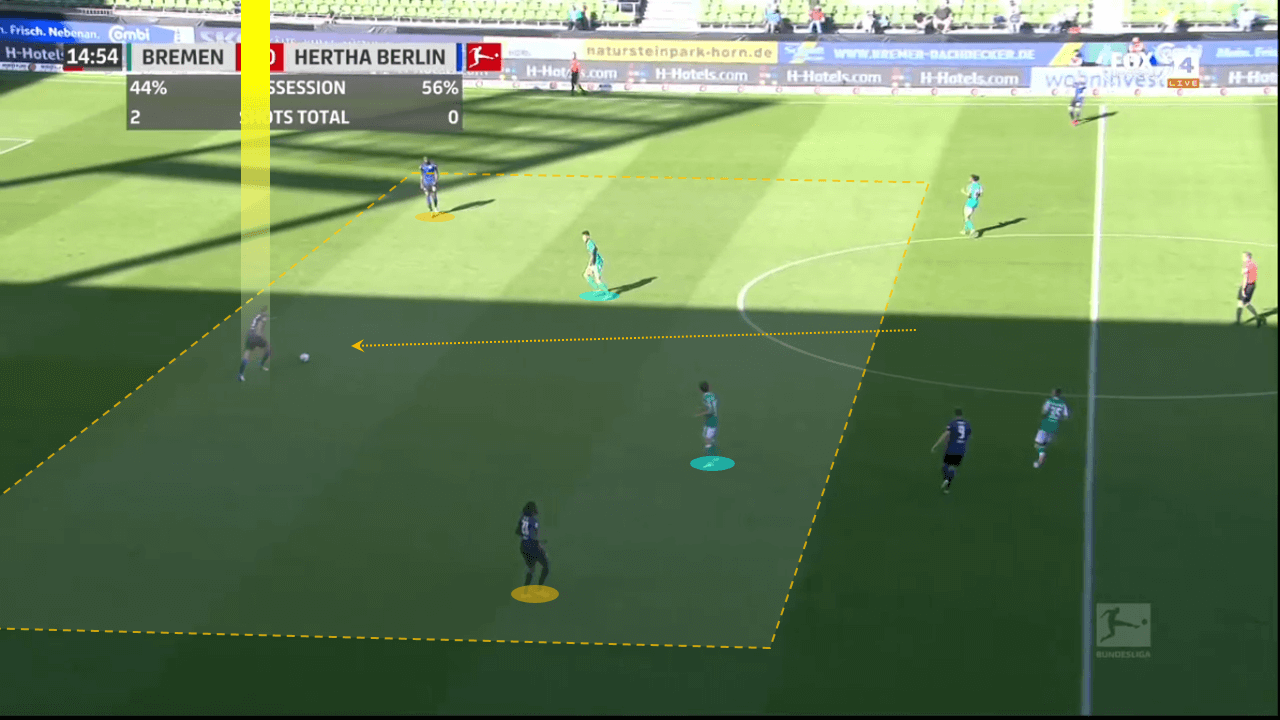
In the first instance above, we see Stark dropping between the two central defenders to make it 3v2 against the two Werder forwards. This movement allowed the fullbacks to move wider and higher and the forwards to stay higher up the pitch.
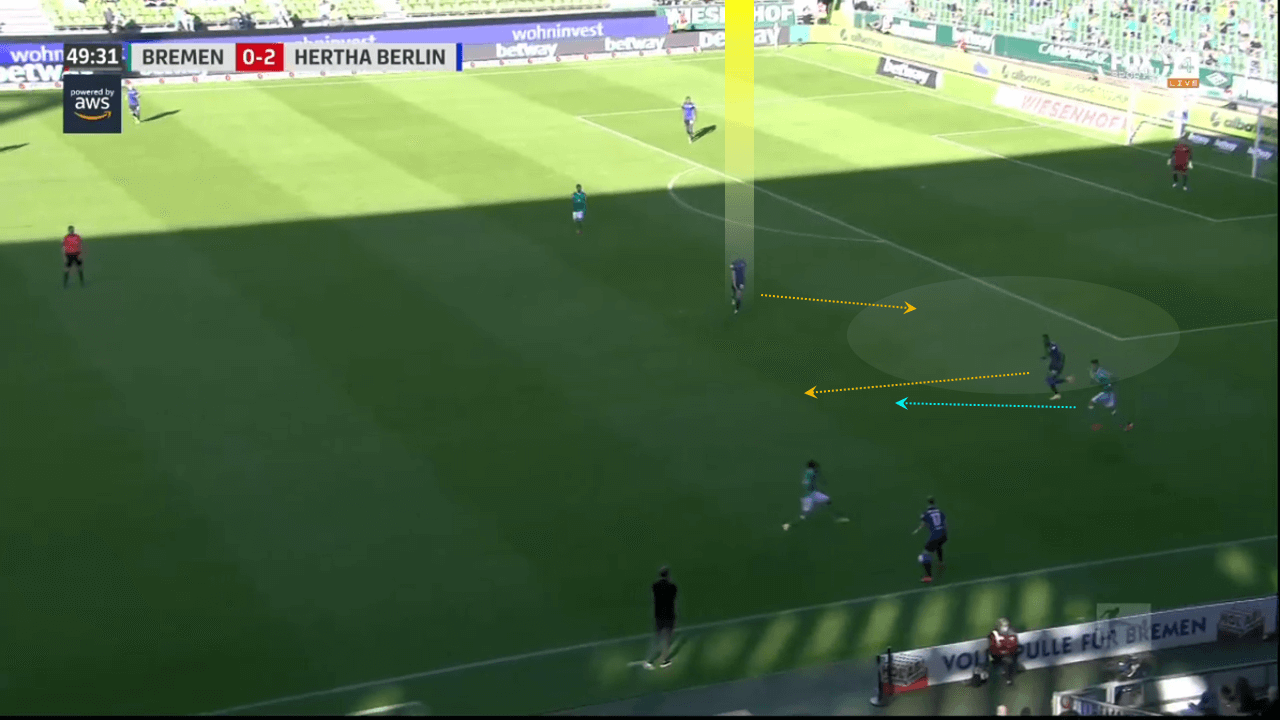
In another instance, we see the ball with Mittelstädt, who is pressed by Chong. Selke is closing the passing lane back to Torunarigha, his centreback. Torunarigha pushes up into the midfield drawing Selke with him. Tousart has dropped from the midfield and drops deeper into the space left by Torunarigha and Selke. He is able to receive the pass from Mittelstädt, and since Bittencourt on the far side does not press him, he is able to turn and find a pass higher up the pitch. Thus a successful rotation enabled the left-back to play out of the pressure.
Although Hertha did play a fair share of long balls into the hole in front of Bremen’s defenders, they managed to win the balls successfully as a result of the numerical superiority over the Werder midfielders. The two central midfielders for Bremen were always outnumbered because of the Hertha midfielders pushing up and the forwards dropping deep.
Let’s look at this scheme below where Lukebakio has dropped from an advanced position in front of Eggestein, while Darida moves further up. We observed similar rotations from Cunha and Piatek quite often and this always made it 4v2 in the middle making it very difficult to control the midfield.
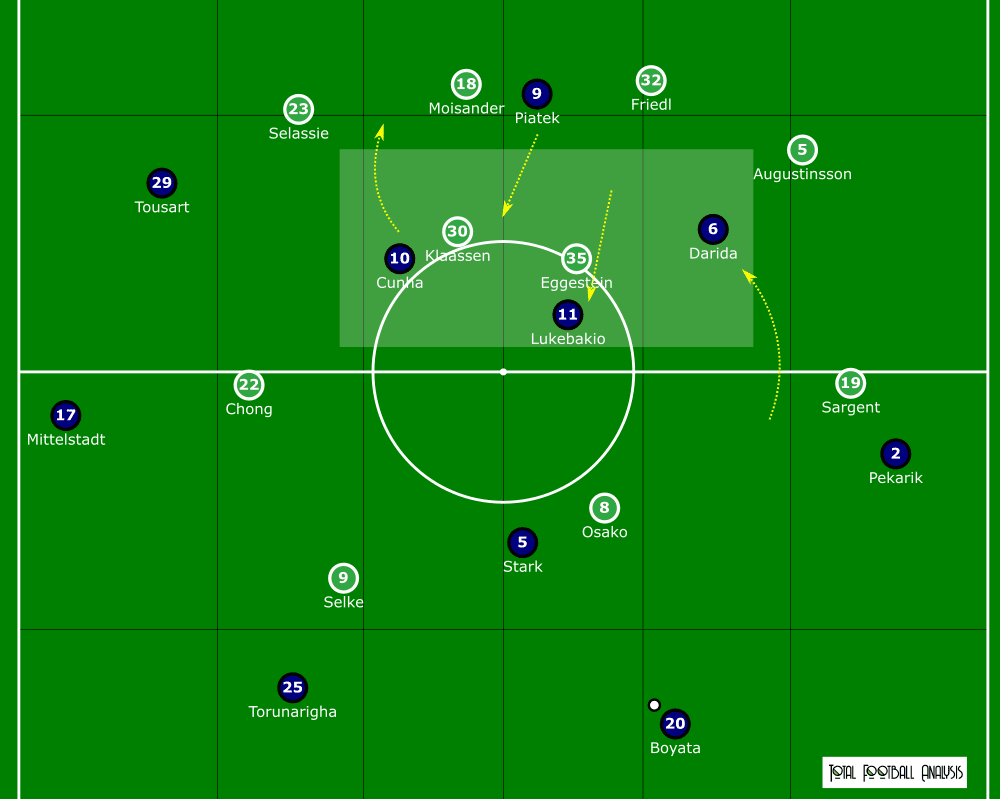
Lukebakio’s heatmap is testament to the forwards extensive work rate in covering areas all over the pitch by virtue of the rotations to receive the ball in deeper positions. Lukebakio was influential in Hertha always finding a free player to play out of the defence.
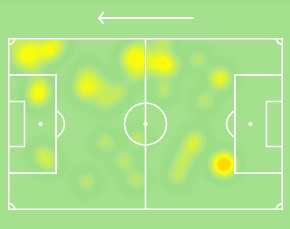
Finally, in this scheme below, we see a very fluid rotation from Hertha. The movement begins with Boyata in possession of the ball looking for options. Pekarik makes a run to the inside fixing Sargent in his zonal position. Lukebakio drops deeper along the half-space from his advanced position drawing Eggestein with him. Darida who moved wide drops along the right flank to replace the space left behind by Pekarik to receive the pass.
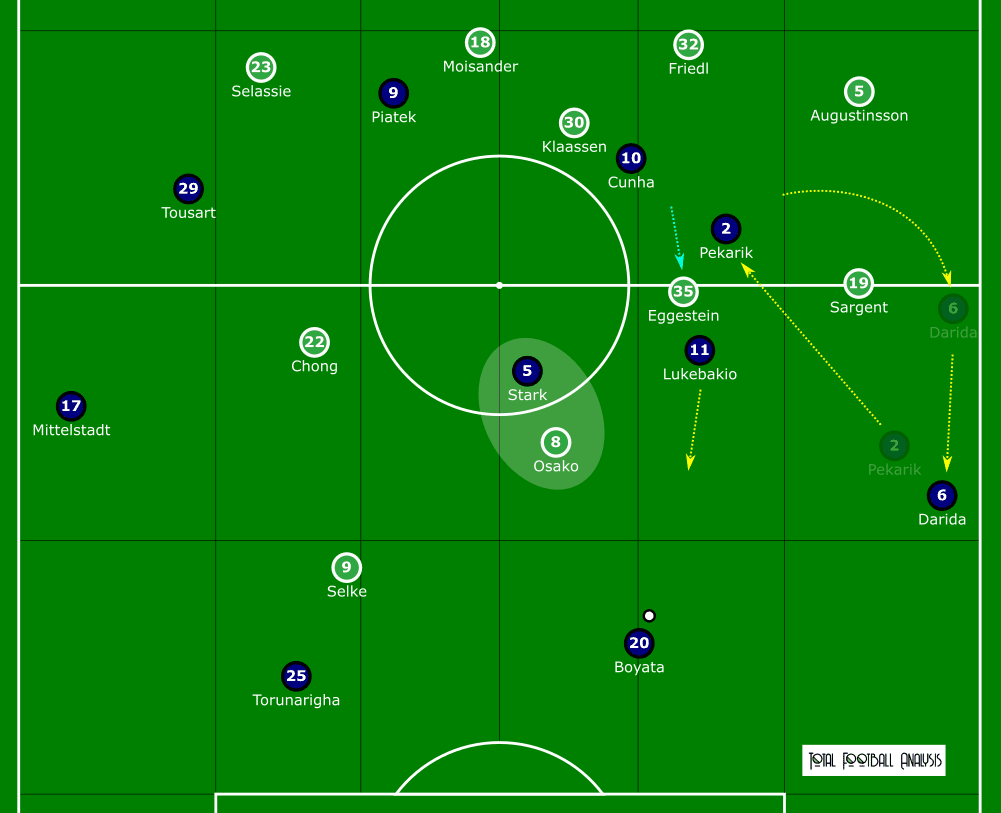
Conclusion
Werder Bremen were very poor in every phase of the game and were overcome easily by Hertha Berlin. Their lack of dominance of the centre of the pitch was a big handicap, but failing to exploit the wide areas made their attack look much uninspired. In my opinion, Kohfeldt needed to come up with a system that allows Chong to attack spaces on the inside while allowing an attacking option on the wing. Playing Chong as a wide midfielder was not the best solution. Starting the game with Selke, Osako and Sargent also backfired as they all have the mentality of forwards and it was difficult for Klaassen to operate alone in the midfield with Eggestein.
Hertha Berlin made a positive start to the season with this win. Their system highlighted the performances of technical players like Cunha and Lukebakio but also showcased the defensive work rate of Stark, Darida and Tousart. Their rotations provide a lot of options and confidence for the defence to play out of the back. They picked the right moments to press and counter-press which proved very effective for them in controlling most phases of the game.





Comments